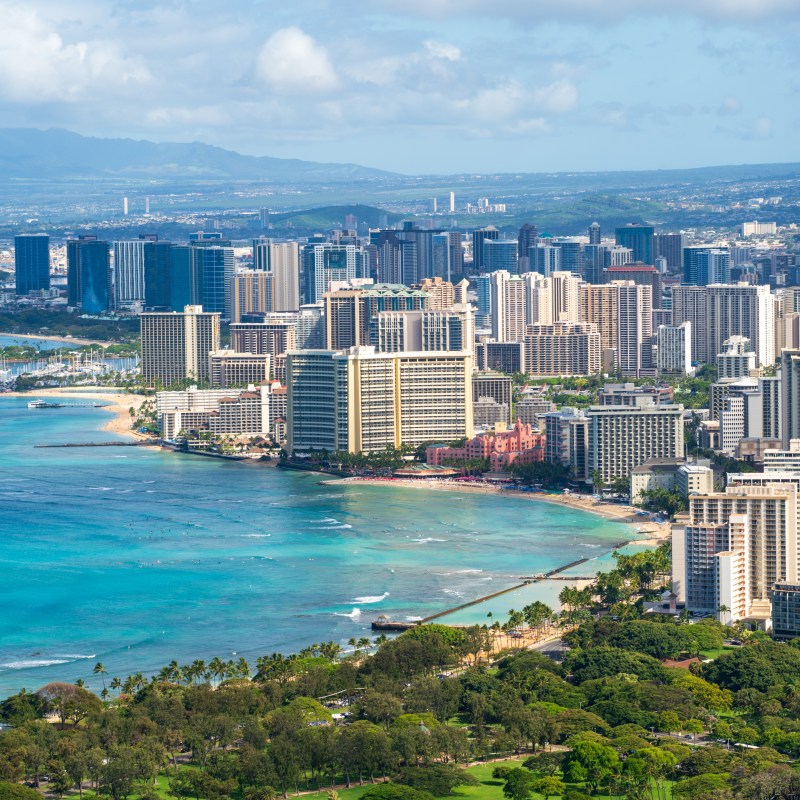
Environmental taxes, ecotaxes, and green taxes. Welcome to a few of the latest buzzwords in the travel industry—and they all point back to sustainability.
Videos by TravelAwaits
Sustainability is top of mind for hospitality groups working in the world’s most gorgeous natural settings. Hawaii is the US’s standout when it comes to tropical settings worth revisiting over and over again.
But given the teeny-tiny size of Hawaii’s islands and their booming population, it’s no surprise that sustainability is a hot topic.
From an economic standpoint, Hawaii must maintain its tropical jungles, pristine beaches, and hiker-friendly mountains. These are the main draws for the millions of tourists who feed local businesses year-round. Without that lush landscape, Hawaii isn’t as attractive to high-spending travelers.
Just think back to the 2023 Maui wildfires. The blaze caused millions in damage while also limiting the number of tourists the area could serve, highlighting just how tenuous the island’s future as a tourist hub is when its land isn’t properly regulated.
Hence, the introduction of the US’s very first Green Tax.
The Green Tax is designed to tackle Hawaii’s most complex problem: the reality that the sheer number of visitors is threatening its tourist industry.
What is the new Green Tax in Hawaii?
In June 2025, Governor Josh Green signed a new Green Tax, which will go into effect on January 1, 2026. The tax will directly fund climate change resiliency projects and boost environmental stewardship.
Environmental stewardship is an academic term for knowing how to take care of a certain type of landscape, whether coastal reefs, rainforests, or volcanic mountains, for example. (I’ve also seen the term ‘custodian’ used to describe this type of work, usually in Australia.)
The Green Tax increases the Transient Accommodations Tax (TAT) to 11% per night, which is a tourist tax that short-term visitors pay. It applies to hotels and short-term rentals. Hawaii’s new Green Tax also adds cruises to the scheme, charging 11% nightly rates even for guests staying onboard, along with added rates for docked ships.
The Green Tax is expected to generate around 100 million in funding, meaning Hawaiian organizations that focus on sustainability, environmental preservation and restoration, and preventing natural disasters will have more money to do their work.
How will the Green Tax affect travelers heading to Hawaii?
Here’s the catch when it comes to the Green Tax: tourists will be footing the bill. Though the taxes are aimed at hotels, short-term rentals, and cruise ships, these companies are likely to pass the bulk of the brunt onto visitors.
You’ll notice pricier room rates, especially on cruise ships heading to the islands.
That might not be the case across the board, though. Some hotels in Hawaii have already launched extensive sustainability programs (like Alohilani Resort) that help save water and energy on their properties, source local ingredients and products, and more. In these cases, hotels might offer free or heavily discounted programs to sweeten the deal for tourists who are wondering why prices have suddenly risen.
In other words, it might be the perfect time to book a stay at a more environmentally-focused hotel when visiting Hawaii in the coming years.
Do any other US states have a Green Tax planned?
Hawaii is the first US state to launch a Green Tax aimed at tourists. However, many other states offer subsidies and other attractive offers to companies that pay environmental dues.
It’s possible that California, Oregon, Washington, and Texas could look to launch the same. Texas is one of the US’s ‘greenest’ states in terms of tax breaks for eco-friendly initiatives, so hotels could implement eco-driven programs to obtain tax breaks, offering a more business-friendly approach to green hospitality.
Internationally, other places have already launched Green Taxes. The most famous are Greece, Bali, Indonesia, and Bhutan. All of their Green Tax programs are aimed at promoting environmental sustainability, often for both local welfare and to maintain the landscapes that tourists love to visit.
